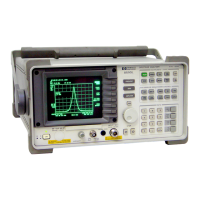236 Chapter4
Troubleshooting the Analyzer
Isolating an RF, LO, IF, or Video Problem
If the displayed signal is distorted
This failure may result in the displayed signal having distinct lobes on
each side. A high noise floor may also be present.
Note that an intermittent hardware failure during the CAL AMPTD
self-calibration routine can cause this type of amplitude failure. The
erroneous calibration data causes the failure symptoms even while the
hardware is operating normally.
1. If the signal looks normal when
CORRECT ON OFF is off, check the
values in the RFATN and SGAIN columns using
DISPLAY CAL DATA
as described in “Using the Internal Service-Diagnostic Routines.”
If a correction factor in either column is greater than two, there may
be a failure on the input attenuator or the A12 amplitude control
assembly.
Refer to Chapter 13 for the description of the corrections that are
disabled when
CORRECT ON OFF is off.
2. Troubleshoot the input attenuator or step gain symptoms with
CORRECT ON OFF turned off.
3. Measure the 321.4 MHz input to the A9 third converter assembly by
connecting the CAL OUT to the INPUT 50Ω with a BNC cable.
75 Ω input only: Connect the CAL OUT to the INPUT 75Ω with the
75 Ω BNC cable.
Then, disconnect the W9 cable assembly from the third converter
and measure at the cable output.
The 321.4 MHz input typically measures between −36 and −39 dBm
with zero input attenuation.
4. Check the signal path from the analyzer input to the output of the
A14 log amplifier assembly. Refer to “IF Power-Level Measurement”
located in Chapter 5 of this service guide.
Recalibration of the analyzer is necessary after the adjustment or
replacement of each suspect assembly. A functioning analyzer may still
appear to be defective if calibration data from before the repair is used.
If the signal is off frequency
This failure may result in the CAL FREQ self-calibration routine failing.
Perform all of the internal service-diagnostic routines.
Refer to “Using the Internal Service-Diagnostic Routines” in this
chapter.

